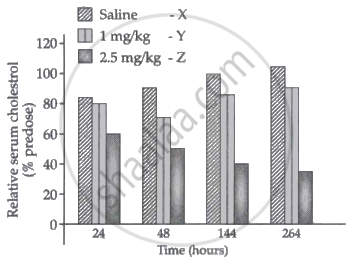Advertisements
Advertisements
प्रश्न
Which part of the plant is best suited for making virus-free plants and why?
उत्तर
Plant's apical and axillary meristems are ideal for producing virus-free plants. This is because the rate of division of a meristematic cell is faster than the rate of multiplication of a virus; hence, viruses are unable to infiltrate newly created meristematic cells. As a result, meristematic cells are virus-free despite the fact that the entire plant is infected. Using a meristem, a healthy plant can be rescued from a diseased plant using the micropropagation process. Virus-free plants such as bananas, sugarcane, and potatoes have been obtained using this method by scientists.
APPEARS IN
संबंधित प्रश्न
what is golden rice.
In the following questions/statements has four suggested answers. Rewrite the correct answer
Bt cotton is resistant to:
(A) Insects
(B) Herbicides
(C) Salt
(D) Drought
Organic farmers prefer biological control of diseases and pests to the use of chemicals for the same purpose. Justify.
What are biofertilizers? Describe their role in agriculture. Why are they preferred to chemical fertilizers?
Explain the term biofortification. How is this technique useful for the production of ‘ golden rice?
Answer the following question.
How is a continuous culture system maintained in bioreactors and why?
Answer the following question.
List any four ways by which GMOs have been useful for enhanced crop output.
Answer the following question.
Write the desirable characters a farmer looks for in his sugarcane crop.
Bt brinjal is an example of transgenic crops. In this Btrefers to ______.
Golden rice is ______.
Golden Rice:
A. GM rice
B. Rich in Vit A
C. Prevents blindness
D. Bruise resistant
Expand GMO. How is it different from a hybrid?
Gene expression can be controlled with the help of RNA. Explain the method with an example.
Bt cotton is resistant to pest, such as lepidopteron, dipterans and coleopterans. Is Bt cotton also resistant to other pests as well?
You have identified a useful gene in bacteria. Make a flow chart of the steps that you would follow to transfer this gene to a plant.
|
RNA interference (RNAi) holds great potential as a therapeutic agent for the treatment of human diseases and as biocontrol agents in controlling pests in the field agriculture. An experiment was carried to study the use of 'RNAi' for the potential treatment of disorders of cholesterol metabolism. Some people possess genetic mutations with elevated levels of ApoB gene which predisposes them to coronary artery diseases. Lowering the amount ApoB can reduce the number of lipoproteins and lower the blood cholesterol. Tracy Zimmerman and her colleagues used RNAi in 2006 to reduce the level of ApoB in non human primates Cynomolgus monkeys. One group of monkeys were given RNAi treatment (small interfering RNAs, SiRNAs) (doses 1 mg/kg, SiRNAs), second group of monkeys were given RNAi treatment (doses 2.5 mg/kg, SiRNAs) and third group of monkeys were injected with saline. |
The results of the study are depicted in the graph below:

- How does the treatment with 2.5 mg/kg bring an effect on cholesterol metabolism when compared from 24 hours and 144 hours?
- Write any two natural sources from where dsRNA molecule could be obtained for silencing the specific mRNA.
- How is RNAi used in controlling the infection on the roots of tobacco plants by the nematode Meloidogyne incognitia?
Name (i) a GM cereal crop having enhanced nutritional value, (ii) the nutrient it is rich in.
"RNA interference has been used to produce transgenic tobacco plants to protect them from the infestation by specific nematodes." Explain the novel strategy exploited by the biotechnologists.
